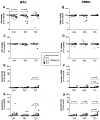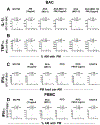Urban airborne particle exposure impairs human lung and blood Mycobacterium tuberculosis immunity
- PMID: 31036772
- PMCID: PMC7162557
- DOI: 10.1136/thoraxjnl-2018-212529
Urban airborne particle exposure impairs human lung and blood Mycobacterium tuberculosis immunity
Abstract
Rationale: Associations between urban (outdoor) airborne particulate matter (PM) exposure and TB and potential biological mechanisms are poorly explored.
Objectives: To examine whether in vivo exposure to urban outdoor PM in Mexico City and in vitro exposure to urban outdoor PM2.5 (< 2.5 µm median aerodynamic diameter) alters human host immune cell responses to Mycobacterium tuberculosis.
Methods: Cellular toxicity (flow cytometry, proliferation assay (MTS assay)), M. tuberculosis and PM2.5 phagocytosis (microscopy), cytokine-producing cells (Enzyme-linked immune absorbent spot (ELISPOT)), and signalling pathway markers (western blot) were examined in bronchoalveolar cells (BAC) and peripheral blood mononuclear cells (PBMC) from healthy, non-smoking, residents of Mexico City (n=35; 13 female, 22 male). In vivo-acquired PM burden in alveolar macrophages (AM) was measured by digital image analysis.
Measurements and main results: In vitro exposure of AM to PM2.5 did not affect M. tuberculosis phagocytosis. High in vivo-acquired AM PM burden reduced constitutive, M. tuberculosis and PM-induced interleukin-1β production in freshly isolated BAC but not in autologous PBMC while it reduced constitutive production of tumour necrosis factor-alpha in both BAC and PBMC. Further, PM burden was positively correlated with constitutive, PM, M. tuberculosis and purified protein derivative (PPD)-induced interferon gamma (IFN-γ) in BAC, and negatively correlated with PPD-induced IFN-γ in PBMC.
Conclusions: Inhalation exposure to urban air pollution PM impairs important components of the protective human lung and systemic immune response against M. tuberculosis. PM load in AM is correlated with altered M. tuberculosis-induced cytokine production in the lung and systemic compartments. Chronic PM exposure with high constitutive expression of proinflammatory cytokines results in relative cellular unresponsiveness.
Keywords: alveolar macrophages; particulate matter; pollution; tuberculosis.
© Author(s) (or their employer(s)) 2019. No commercial re-use. See rights and permissions. Published by BMJ.
Conflict of interest statement
Competing interests: None declared.
Figures





References
-
- Nations U. World urbanization prospects: the 2018 revision, 2018.
-
- Organization WH. Who fact sheet No. 292, household air pollution and health 2016. Available: http://www.who.int/mediacentre/factsheets/fs292/en/
-
- Bowe B, Xie Y, Li T, et al. Global and national burden of diabetes mellitus attributable to PM2.5 air pollution. Lancet Planet Health 2016;2018:e301–12. - PubMed
-
- Saenen ND, Bové H, Steuwe C, et al. Children’s urinary environmental carbon load. A novel marker reflecting residential ambient air pollution exposure? Am J Respir Crit Care Med 2017;196:873–81. - PubMed
Publication types
MeSH terms
Substances
Grants and funding
LinkOut - more resources
Full Text Sources
